
Mullagrach Island, the most northerly of Scotland’s Summer Isles, has been put on the market for £500,000, offering the ultimate remote getaway. This secluded island spans 88.7 acres, featuring lush greenery, beaches, cliffs, and caves perfect for exploration. Located two hours from Inverness and a 35-minute boat ride from the mainland, it provides an unparalleled escape from modern life. Marketed by Galbraith in the Highland capital, the island was purchased 18 years ago Continue reading “The Ultimate Getaway: Remote Scots Island With a Tiny Log Cabin is Put on the Market for £500,000” »

In a transformative initiative, former nuclear weapons sites in the United States are being repurposed to host solar farms, aiming to generate clean energy for thousands of homes. This is part of the “Cleanup to Clean Energy” program by the Department of Energy, which seeks to utilize land previously designated for the development and storage of nuclear weapons for sustainable energy production. The Idaho National Laboratory (INL), a key participant in this program, is set to host Continue reading “US Puts Solar Panels on Old Nuclear Weapons Sites for Powering 70,000 Homes” »

James Kane and Barbi Agostini, magnet fishing enthusiasts from Queens, New York, reeled in an unexpected windfall when they discovered a safe filled with an estimated $80,000 while fishing in Flushing Meadows Corona Park. Kane, 40, and Agostini, 39, had taken up the hobby during the pandemic and were stunned by the stacks of hundred-dollar bills inside the muddy lockbox. Kane immediately sensed their lives were about to change dramatically. The couple, who share their magnet fishing adventures on social media, initially couldn’t believe their luck, especially Agostini, who rarely considered herself fortunate in games of chance.

After the discovery, Kane and Agostini promptly informed the New York City police, who evaluated the situation and determined that the disintegrated condition of the currency made it difficult to ascertain its value and authenticity. Despite this, the couple was allowed to keep the money, and they plan to take the bills to the Bureau of Engraving and Printing in Washington, D.C., for restoration, a process that could take years. They estimate the haul to be between $40,000 and $80,000, with hopes of salvaging around $60,000. Beyond their significant find, the couple’s magnet fishing ventures across New York’s boroughs have yielded a range of items, from firearms to a racing motorcycle, which they have responsibly turned over to the authorities. Their incredible find has them dreaming of a future property filled with animals and open space, a far cry from their city-based adventures.

LEGO has unveiled a stunning 1506-piece replica of the iconic Lamborghini Countach 5000 Quattrovalvole, designed to capture the essence and detail of the original supercar. This meticulously crafted model features all the hallmarks of the legendary 1980s vehicle, including the distinctive scissor doors, a massive rear spoiler, and an openable hood and trunk that reveal a proportionally accurate V12 engine. The attention to detail extends to the interior, with a detailed cockpit, deep-dish rims, expansive taillights, and a sleek rear spoiler, ensuring that this LEGO build is as close to the real thing as possible. It stands as a testament to LEGO’s commitment to creating authentic and captivating replicas, making it an impressive display piece for any car enthusiast’s home or office.
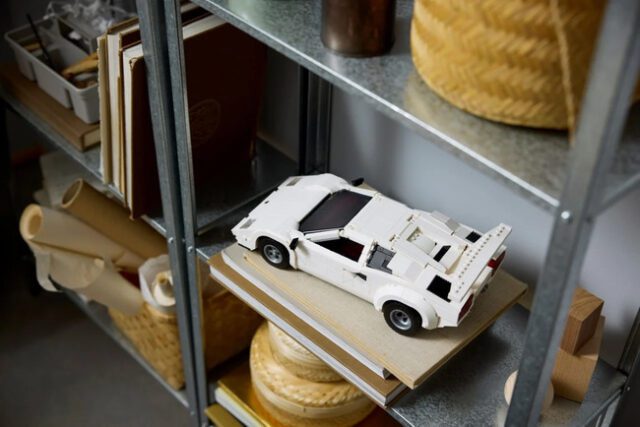
Beyond its visual appeal, the LEGO Lamborghini Countach offers an engaging building experience, allowing builders to explore the car’s intricate inner workings. The model features a working steering wheel and opening components that provide access to the detailed engine compartment, showcasing the powerful V12 engine replicated in LEGO form. Measuring over 3.5 inches high, 13 inches long, and 6.5 inches wide, the finished model is a substantial and eye-catching centerpiece. Additionally, the set includes digital building instructions available through the LEGO Builder app, offering an interactive and alternative way to follow the construction process. Priced at $179.99, this impressive LEGO set will be available online and in stores starting July 4th, making it a must-have for both LEGO fans and automotive aficionados.
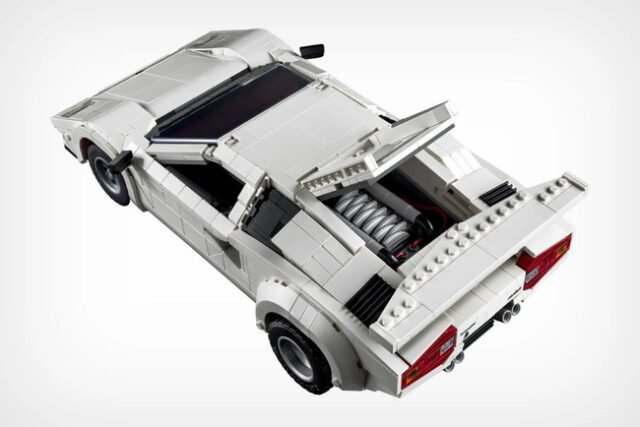






La Maison du Bonheur, or House of Happiness, is an innovative tiny home designed by Baluchon that merges practicality with playfulness. Unlike conventional tiny homes, this 20-foot-long abode, set on a double-axle trailer, incorporates a dedicated play area complete with a climbing wall and slide. Commissioned by Siana, the homeowner, the design fulfills a dual purpose: serving as a delightful playroom for her daughter and friends while having the potential to transform into a traditional living space as the child grows older. The home’s exterior features a blend of red cedar and aluminum cladding, and it is powered via a standard RV-style hookup. The play area, occupying what would typically be the living room, includes a small playhouse, a climbing wall, and ample storage for toys and books, all bathed in natural light through generous glazing.
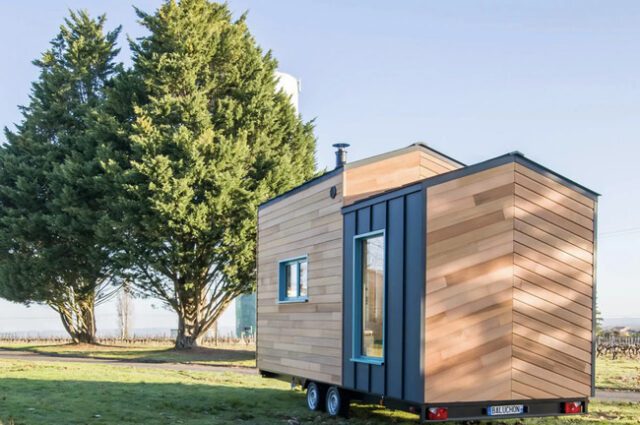
Beyond the playful design, La Maison du Bonheur retains all the essential features of a tiny home. It houses a dining table with seating for three, and a compact kitchen equipped with a two-burner propane stove, sink, refrigerator, and ample cabinetry. The bathroom includes a shower and toilet, ensuring full functionality. A unique staircase integrated into the slide and dining area leads to a cozy loft-style bedroom, complete with storage and a bed under a low ceiling. Delivered to its location in southeast France, this versatile tiny home epitomizes both whimsy and practicality. While the exact pricing remains undisclosed, Baluchon’s tiny homes typically start at around $85,000, making La Maison du Bonheur an attainable dream for those seeking a compact yet dynamic living space.



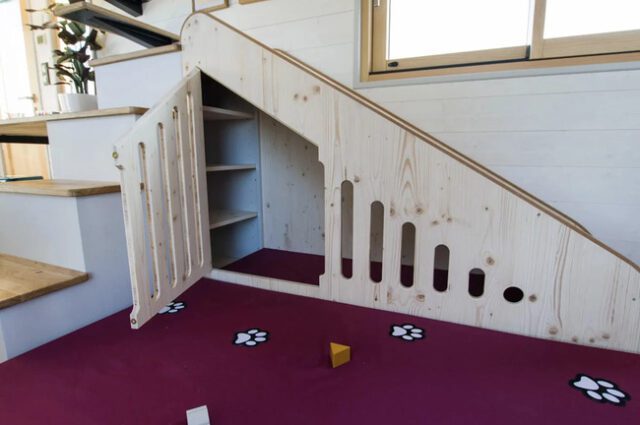
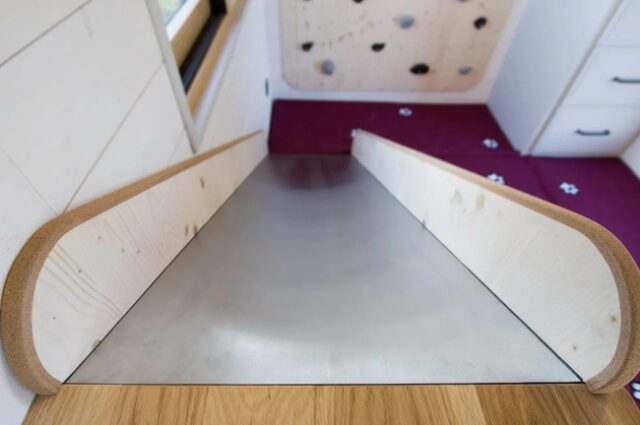
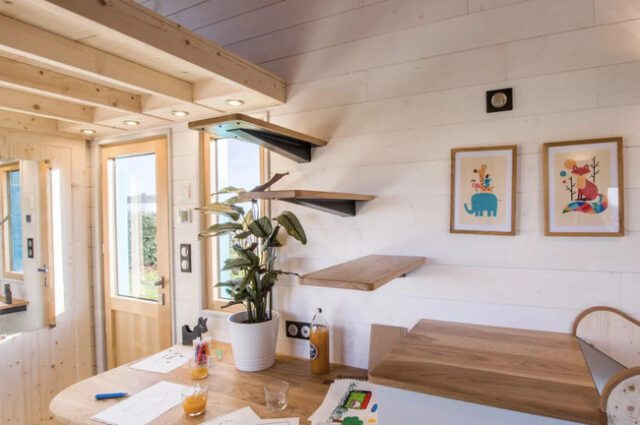
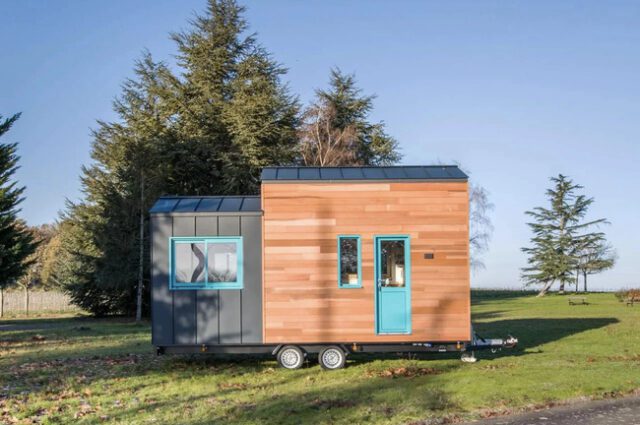

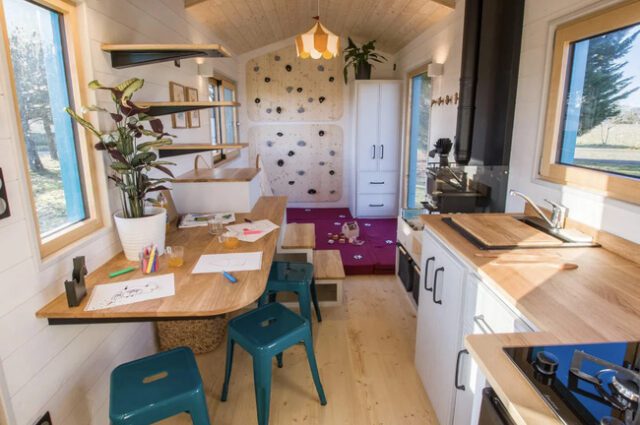

Maisy Dewey, a dual citizen of the U.S. and the U.K., always dreamt of living in London, influenced by her British father and American mother, who balanced their lives between the two countries. Growing up in New Jersey, Dewey regularly visited London with her family, fostering a deep connection to the city. In 2022, Dewey and her fiancé, Harrison Kent, decided to make the move from Philadelphia to London when Kent was accepted into Kingston University’s Product & Furniture Design degree. They began an extensive preparation for their move, including selling their belongings in yard sales and raising $3,000 to help fund their transatlantic journey.
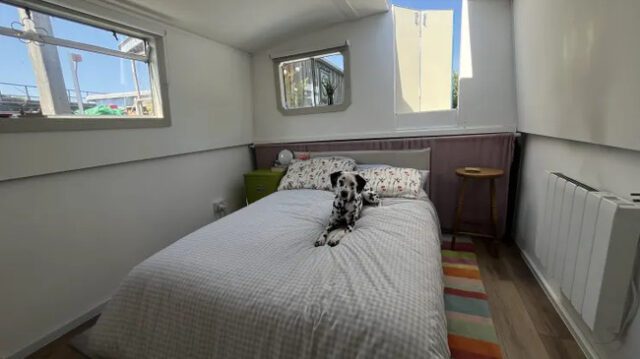
Finding a home in London while still in Philadelphia proved challenging for the couple, leading them to settle on a short-term rental initially. However, their luck changed when a real estate agent introduced them to a 65-ft wide beam houseboat. Despite initial skepticism, especially concerning their Dalmatian, Kipper, they were pleasantly surprised by the newly renovated boat’s spacious and comfortable layout. The houseboat, featuring a living room, two bedrooms, a full bathroom, and a kitchen, became their new home for $2,236 monthly. They embraced the unique lifestyle, enjoying the blend of outdoor and indoor living and the close-knit community at the dock. Over six months in, Dewey and Kent feel more at home than ever, relishing their unique floating residence and the idyllic lifestyle it affords them.

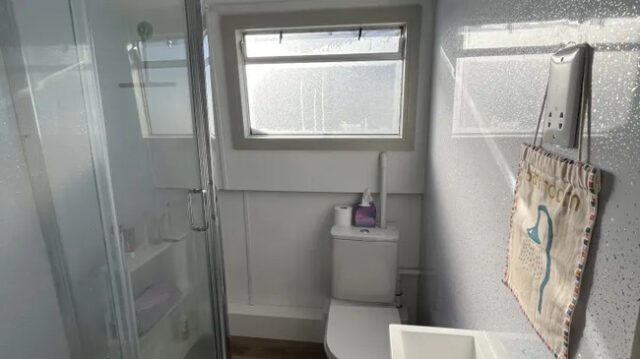
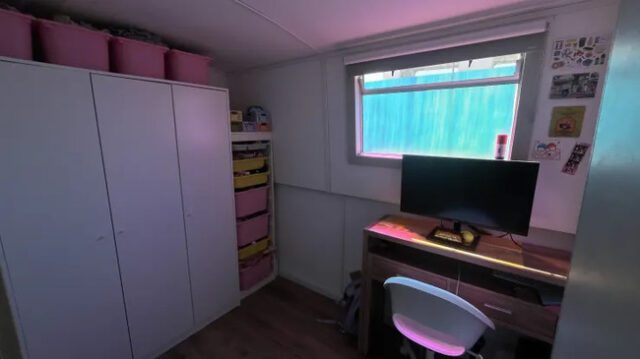
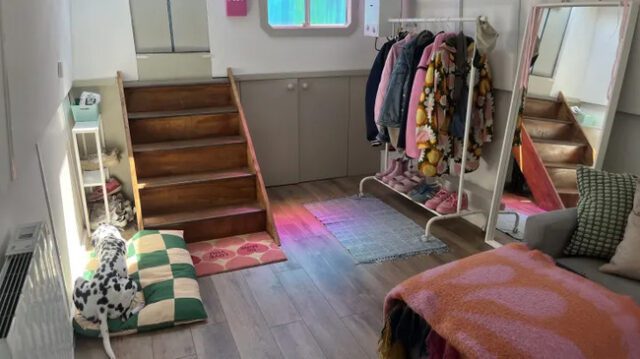


Trendy “Anatomy Fashion” turns our insides into outside style with the help of AI, showcasing the innovative work of Hungarian artist David Szauder. Known for his digital collages, Szauder has harnessed the power of AI to elevate his creativity, using platforms like Midjourney and Photoshop to transform the human body into chic streetwear. His Instagram feed, which boasts a significant following, serves as a gallery for his free-flowing ideas. One standout series features anatomical sweaters and hoodies, inspired by Szauder’s curiosity about the unseen parts of our bodies. These designs not only turn heads with their trendy aesthetics but also aim to bridge the gap between our awareness and the hidden aspects of our anatomy. As Szauder explains, by making these invisible parts visible through fashion, he hopes to foster a deeper appreciation and understanding of our bodies.

Szauder’s anatomy fashion is a testament to his skill in utilizing new technologies to achieve unprecedented creative freedom. After gathering materials like textures and anatomical illustrations, he meticulously constructs each image, likening the process to directing a film. AI allows him to refine every detail, from lighting and poses to colors and camera angles, resulting in hyper-realistic and captivating visuals. This technological advancement not only eliminates the technical limitations of traditional digital collages but also enables Szauder to focus more on the conceptual and artistic aspects Continue reading “Trendy “Anatomy Fashion” Turns Our Insides Into Outside Style With Help From AI” »

Theo-Will McKenna, who lost his cat Artie 12 years ago, experienced an emotional reunion when the cat was unexpectedly found in Connah’s Quay, Wales. McKenna, who was 17 at the time of Artie’s disappearance, had spent countless hours searching for his beloved grey and white feline, to no avail. The heartbreak of not finding Artie lingered, leading McKenna to eventually lose hope, believing either tragedy had struck or someone else had taken Artie in. Continue reading “Missing for 12 Years, ‘Beloved’ Cat Named Artie Finally Reunited with His Family” »

In late May, Brazilian President Luis Ignacio da Silva visited São Paulo to inaugurate the world’s largest manufacturing plant for second-generation ethanol. The Bonfim Bioenergy Park, located in Guariba, São Paulo, will produce 82 million liters of ethanol annually using a revolutionary method that cuts emissions by 30%. This innovative process involves converting bagasse, the fibrous waste from sugarcane processing, into ethanol. Raízen, the company behind this plant, has integrated advanced technologies to extract residual sucrose from the crushed canes and utilize enzymes in a hydrolysis process to break down cellulose fibers for fermentation. This approach not only enhances the sustainability of ethanol production but also significantly reduces the carbon footprint compared to traditional methods.

The inauguration of the Bonfim Bioenergy Park marks a significant milestone in Brazil’s biofuel industry, positioning the country as a leader in sustainable energy. Raízen plans to expand its second-generation ethanol production with nine additional plants under construction, aiming to produce 1.6 billion liters of biofuel annually. This advancement aligns with Brazil’s extensive use of ethanol as an engine fuel, where 90% of new gasoline-powered cars can operate on hydrous ethanol. The environmental impact is profound, with studies indicating that bioethanol use can reduce emissions by 50-60% compared to conventional fuels. President da Silva highlighted the achievement, emphasizing that Brazil’s innovation in transforming bagasse into high-quality ethanol demonstrates the country’s leadership in sustainable energy solutions.




















































